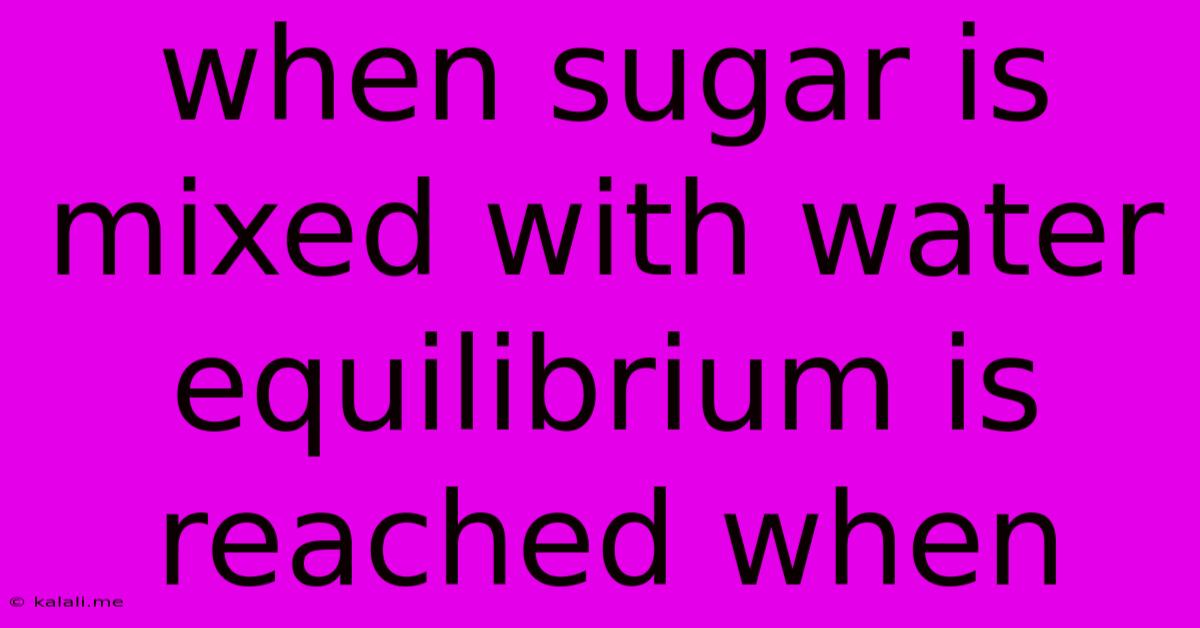When Sugar Is Mixed With Water Equilibrium Is Reached When
Kalali
May 09, 2025 · 3 min read

Table of Contents
When Sugar is Mixed with Water: Equilibrium Explained
When sugar dissolves in water, it doesn't just disappear; it reaches a state of dynamic equilibrium. This seemingly simple process is a fascinating example of how solutions behave at a molecular level. This article will explore exactly when equilibrium is reached, the factors influencing it, and the science behind this common occurrence.
Understanding Dynamic Equilibrium
The key to understanding sugar dissolving in water lies in the concept of dynamic equilibrium. It's not a static endpoint, but rather a balance between two opposing processes:
- Dissolution: Sugar molecules (sucrose) break away from the crystal lattice and enter the water, becoming surrounded by water molecules (hydration).
- Precipitation: Sugar molecules in the solution collide and re-attach to the existing sugar crystals, leaving the solution.
Equilibrium is reached when the rate of dissolution equals the rate of precipitation. This doesn't mean there's no further movement; sugar molecules are constantly dissolving and precipitating, but the net change in concentration remains zero. The solution becomes saturated.
Factors Affecting Equilibrium in Sugar-Water Solutions
Several factors influence when equilibrium is reached and the concentration of sugar at saturation:
-
Temperature: Higher temperatures generally increase the solubility of sugar. Warmer water can hold more dissolved sugar before reaching saturation. This is because increased kinetic energy facilitates the breaking of sugar-sugar bonds in the crystal.
-
Amount of Sugar: The more sugar you add to a given volume of water, the longer it will take to reach equilibrium, and the higher the concentration of sugar at saturation will be. Eventually, you'll reach a point where no more sugar dissolves, no matter how much you add.
-
Type of Sugar: Different sugars have different solubilities. While sucrose (table sugar) is highly soluble, other sugars like fructose or glucose will have slightly different saturation points.
-
Presence of Other Solutes: Adding other substances to the water can impact sugar solubility. This effect depends on the interaction between the sugar, water, and the other solute(s).
Identifying Equilibrium: Saturation
You know equilibrium has been reached when the solution is saturated. This means that no more sugar will dissolve; any additional sugar added will simply settle at the bottom of the container. You can visually confirm this by observing undissolved sugar crystals remaining in the solution.
Beyond Simple Saturation: Supersaturation
It's possible to create a supersaturated solution – a solution holding more dissolved solute than it would at equilibrium. This is typically achieved by carefully cooling a hot, saturated solution without disturbing it. However, these solutions are unstable, and adding a seed crystal or even slight agitation can trigger rapid precipitation, returning the solution to equilibrium.
The Importance of Equilibrium in Everyday Life
Understanding dynamic equilibrium is crucial in various contexts:
-
Food Science: Knowing the solubility of different sugars helps in creating confectionery and beverages with precise sweetness.
-
Pharmacology: Solubility dictates how effectively drugs dissolve and are absorbed into the body.
-
Environmental Science: Understanding equilibrium helps model the behavior of pollutants in water systems.
In Conclusion:
The seemingly simple process of dissolving sugar in water showcases the complex concept of dynamic equilibrium. Equilibrium is reached when the rate of dissolution equals the rate of precipitation, resulting in a saturated solution. Factors like temperature, amount of sugar, and other solutes influence this process, highlighting the intricate interplay between molecules in a solution. Understanding this fundamental concept has wide-ranging applications in various scientific fields.
Latest Posts
Related Post
Thank you for visiting our website which covers about When Sugar Is Mixed With Water Equilibrium Is Reached When . We hope the information provided has been useful to you. Feel free to contact us if you have any questions or need further assistance. See you next time and don't miss to bookmark.